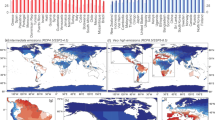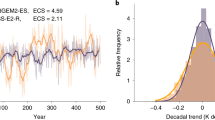Abstract
Our understanding of mankind’s influence on the climate is largely based on computer simulations1,2. Model output is typically averaged over several decades3 so that the anthropogenic climate change signal stands out from the largely unpredictable ‘noise’ of climate variability. Similar averaging periods (30-year) are used for regional climate projections4,5,6 to inform adaptation. According to two such projections, UKCIP02 (ref. 4) and UKCP09 (ref. 6), the UK will experience ‘hotter drier summers and warmer wetter winters’7,8 in the future. This message is about a typical rather than any individual future season, and these projections should not be compared directly to observed weather as this neglects the sizeable contribution from year-to-year climate variability. Therefore, despite the apparent contradiction with the messages, it is a fallacy to suggest the recent cold UK winters like 2009/2010 disprove human-made climate change9. Nevertheless, such claims understandably cause public confusion and doubt10. Here we include year-to-year variability to provide projections for individual seasons. This approach has two advantages. First, it allows fair comparisons with recent weather events, for instance showing that recent cold winters are within projected ranges. Second, it allows the projections to be expressed in terms of the extreme hot, cold, wet or dry seasons that impact society, providing a better idea of adaptation needs.
This is a preview of subscription content, access via your institution
Access options
Subscribe to this journal
Receive 12 print issues and online access
$209.00 per year
only $17.42 per issue
Buy this article
- Purchase on Springer Link
- Instant access to full article PDF
Prices may be subject to local taxes which are calculated during checkout




Similar content being viewed by others
Change history
06 August 2015
In the version of this Letter originally published, the use of UK versus England/Wales was inconsistent. The text has been amended to clarify throughout. These errors have been corrected in all versions of the Letter.
References
Manabe, S. & Wetherald, R. T. Thermal equilibrium of the atmosphere with a given distribution of relative humidity. J. Atmos. Sci. 24, 241–259 (1967).
Hansen, J. et al. Climate impact of increasing atmospheric carbon dioxide. Science 213, 957–966 (1981).
Stott, P. A. & Tett, S. F. B. Scale-dependent detection of climate change. J. Clim. 11, 3282–3294 (1998).
Hulme, M. et al. Climate-Change Scenarios for the United Kingdom: The UKCIP02 Scientific Report (Tyndall Centre for Climate Change Research, School of Environmental Sciences, University of East Anglia, 2002)
Christensen, J. H. et al. in Climate Change 2007: The Physical Science Basis (eds Solomon, S. et al.) Ch. 11, 847–940 (IPCC, Cambridge Univ. Press, 2007).
Murphy, J. M. et al. UK Climate Projections Science Report: Climate Change Projections (Met Office Hadley Centre, 2009).
Adapting to climate change in the UK, POST Note July 2006 Number 267 (POST, 2006); http://www.parliament.uk/briefing-papers/POST-PN-267.pdf
Adapting to Climate Change: UK Climate Projections 2009 (DEFRA, 2011); https://www.gov.uk/government/publications/adapting-to-climate-change-uk-climate-projections-2009
Brown, M. Snow chaos: And they still claim it is global warming. Daily Express (6 January 2010)
Spence, A., Venables, D., Pidgeon, N. F., Poortinga, W. & Demski, C. Public Perceptions of Climate Change and Energy Futures in Britain. Summary Findings of a Survey Conducted in January–March 2010 (Technical Report) (Cardiff Univ., 2010); http://www.understanding-risk.org
Räisänen, J. & Ruokolainen, L. Estimating present climate in a warming world: A model-based approach. Clim. Dynam. 31, 573–585 (2008).
Räisänen, J. & Ylhäisi, J. S. Cold months in a warming climate. Geophys. Res. Lett. 38, L22704 (2011).
Meehl, G. A. et al. The WCRP CMIP3 multi-model dataset: A new era in climate change research. Bull. Am. Meteorol. Soc. 88, 1383–1394 (2007).
Sexton, D. M. H., Murphy, J. M., Collins, M. & Webb, M. J. Multivariate prediction using imperfect climate models part I: Outline of methodology. Clim. Dynam. 38, 2513–2542 (2012).
Harris, G. R., Sexton, D. M. H., Booth, B. B. B., Collins, M. & Murphy, J. M. Probabilistic projections of transient climate change. Clim. Dynam. 40, 2937–2972 (2013).
Rougier, J. Probabilistic inference for future climate using an ensemble of climate model evaluations. Climatic Change 81, 247–264 (2007).
Stott, P. A., Stone, D. A. & Allen, M. R. Human contribution to the European heatwave of 2003. Nature 432, 610–614 (2004).
Pall, P. et al. Anthropogenic greenhouse gas contribution to flood risk in England and Wales in autumn 2000. Nature 470, 382–386 (2011).
Cattiaux, J. et al. Winter 2010 in Europe: A cold extreme in a warming climate. Geophys. Res. Lett. 37, L20704 (2010).
Pidgeon, N. & Fischhoff, B. The role of social and decision sciences in communicating uncertain climate risks. Nature Clim. Change 1, 35–41 (2011).
Knutti, R. The end of model democracy? Climatic Change 102, 395–404 (2010).
Sexton, D. M. H. & Murphy, J. M. Multivariate prediction using imperfect climate models part II: Robustness of methodological choices and consequences for climate sensitivity. Clim. Dynam. 38, 2543–2558 (2012).
Hulme, M., Dessai, S., Lorenzoni, I. & Nelson, D. R. Unstable climates: Exploring the statistical and social constructions of ’normal’ climate. Geoforum 40, 197–206 (2009).
Scaife, A. A. et al. Climate change and stratosphere–troposphere interaction. Clim. Dynam. 38, 2089–2097 (2012).
Scaife, A. A. et al. Improved Atlantic winter blocking in a climate model. Geophys. Res. Lett. 38, L23703 (2011).
Bony, S. & Dufresne, J.-L. Marine boundary layer clouds at the heart of cloud feedback uncertainties in climate models. Geophys. Res. Lett. 32, L20806 (2005).
Morice, C. P., Kennedy, J. J., Rayner, N. A. & Jones, P. D. Quantifying uncertainties in global and regional temperature change using an ensemble of observational estimates: The HadCRUT4 dataset. J. Geophys. Res. 117, D08101 (2012).
Perry, M. C. & Hollis, D. M. The generation of monthly gridded datasets for a range of climatic variables over the UK. Int. J. Clim. 25, 1041–1054 (2005).
Nakicenovic, N. J. et al. Special Report on Emissions Scenarios (eds Nakicenovic, N. & Swart, R.) (IPCC, Cambridge Univ. Press, 2000).
Acknowledgements
We would like to thank L. Kendon for encouraging us to think about this issue. We would also like to thank S. Belcher, B. Booth, S. Brown, K. Humphrey, V. Pope, A. Scaife, R. Street and colleagues at the Isaac Newton Workshop on ‘Mathematical and statistical approaches to climate modelling and prediction’ and, in particular, J. Murphy for comments. This work was supported by the Met Office Hadley Centre Climate Programme—DECC/Defra (GA01101). We acknowledge the international modelling groups for providing their data for analysis, the Program for Climate Model Diagnosis and Intercomparison (PCMDI) for collecting and archiving the model data, the JSC/CLIVAR Working Group on Coupled Modelling (GCM) and their Coupled Model Intercomparison Project (CMIP) and Climate Simulation Panel for organizing the model data analysis activity, and the IPCC WG1 TSU for technical support. The IPCC Data Archive at Lawrence Livermore National Laboratory is supported by the Office of Science, US Department of Energy.
Author information
Authors and Affiliations
Contributions
D.M.H.S. and G.R.H. both conceived the method. D.M.H.S. coded up the solution by modifying the original code of G.R.H. and D.M.H.S. which was used to produce UKCP09. D.M.H.S. drafted the initial version of the manuscript and Supplementary Information and made the plots. Both authors discussed the results and implications, and commented on the manuscript at all stages.
Corresponding author
Ethics declarations
Competing interests
The authors declare no competing financial interests.
Supplementary information
Rights and permissions
About this article
Cite this article
Sexton, D., Harris, G. The importance of including variability in climate change projections used for adaptation. Nature Clim Change 5, 931–936 (2015). https://doi.org/10.1038/nclimate2705
Received:
Accepted:
Published:
Issue Date:
DOI: https://doi.org/10.1038/nclimate2705
This article is cited by
-
Perceptions and strategies of adaptation of Moroccan farmers to climate change—case of Khemisset province
Journal of Environmental Studies and Sciences (2024)
-
Variability conceals emerging trend in 100yr projections of UK local hourly rainfall extremes
Nature Communications (2023)
-
Regional Climate Impacts of Future Changes in the Mid–Latitude Atmospheric Circulation: a Storyline View
Current Climate Change Reports (2019)
-
Intercomparison of model response and internal variability across climate model ensembles
Climate Dynamics (2018)
-
An AOGCM based assessment of interseasonal variability in Pakistan
Climate Dynamics (2018)



